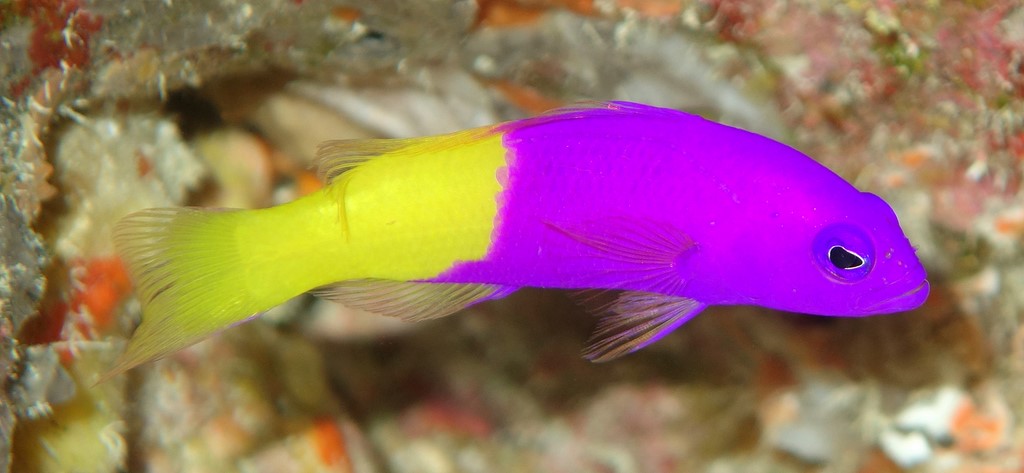PICTICHROMIS CORALENSIS - (GILL, 2004)
icture courtesy of: Alain Daoulas
Pseudochromis mi-jaune mi-violet, Bicoloured dottyback, Bicolor cichlops, Two-colour dottyback, Two-tone dottyback, Coral Sea dottyback,
Description
Dorsal spines (total): 3; Dorsal soft rays (total): 21-22 (usually: 21); Anal spines: 3; Anal soft rays: 11-12; Pectoral fin rays: 16-18; Upper procurrent caudal-fin rays: 6-8 (usually: 7); Lower procurrent caudal-fin rays: 6-7 (usually: 7); Total caudal fin rays: 29-32 (usually: 31); Scales in lateral series: 36-43 (usually: 38-40); Anterior lateral line scales: 21-28 (usually: 22-24); Anterior lateral line terminating beneath segmented dorsal-fin ray: 10-15 (usually: 12-14); Posterior lateral line scales: 0-10 + 0; Scales between lateral lines: 3-4. Lower lip incomplete; Dorsal and anal fins without distinct scale sheaths, although sometimes with intermittent scales overlapping fin bases; Predorsal scales extending anteriorly to point ranging from anterior to posterior nostrils; Opercle with 4-10 usually relatively distinct serrations. Anal-fin spines moderately stout to stout and pungent, second spine stouter than third; Pelvic-fin spine moderately stout to stout and pungent; Second segmented pelvic-fin ray longest; Caudal fin truncate to emarginate; Vertebrae: 10+16; Epineurals: 12-15; Epurals: 3. Upper jaw with 2-4 pairs of curved, enlarged caninifonn teeth anteriorly, and 4-5 (at symphysis) to 1-3 (on sides of jaw) inner rows of small conical teeth, outermost of rows of conical teeth much larger and more curved than inner rows. Max. length: 7.0 cm TL. Depth range: 6 - 40 m.
Color
Head and body anterior to more-or-less vertical (often oblique, concave or convex) line near anal-fin origin magenta, remainder of body and caudal peduncle bright yellow; Magenta and bright yellow regions sometimes separated by narrow pale pink to white bar; Iris pinkish to magenta with purplish blue to blue suboval ring around pupil; Anterior part of dorsal fin where adjacent to magenta portion of body with magenta rays and pinkish to purplish hyaline or hyaline interradial membranes; Remainder of dorsal fin with bright yellow rays and yellowish hyaline interradial membranes; Anal fin with bright yellow rays and yellowish hyaline interradial membranes, sometimes with one or two bright yellow stripes along basal half of fin; Anal-fin spines often magenta or blue to bluish violet; Caudal fin with rays and basal area bright yellow, interradial membranesbecoming yellowish hyaline posteriorly; Upper and lower margins of caudal fin pale blue to bluish violet or magenta; Pectoral fins pinkish hyaline; Pelvic fins pinkish to yellowish hyaline, fin spines pale blue to magenta.
Etymology
Pictichromis: from Latin, pictus = painted, colored + from Greek, chromis, a genus of pomacentrid, used as the stem for other fish genera; Alludes to the bright live colorations of the included species.
coralensis: named for the known distribution of the species, the Coral Sea.
Original description: Pictichromis coralensis Gill, 2004 - Type locality: Lihou Reef, Great Barrier Reef, Australia, depth 2-25 meters.
Distribution
Southwestern Pacific: Queensland (Australia) and New Caledonia.
Biology
Inhabits caves in coral and rock reefs on reef slopes and dropoffs. Aquarium fish.
Similar Species
Pictichromis paccagnellorum (Axelrod, 1973) - Reported from Southeastern Indian Ocean, western Pacific: eastern Indonesia, Papua New Guinea, Solomon Islands and Western Australia. Pictichromis coralensis was distinguished from Pictichromis paccagnellae mainly by having fewer scales in longitudinal series on the body.
Pictichromis dinar (Randall & Schultz, 2009) - Reported from Sulawesi, Indonesia. Pictichromis dinar differs in color from the very similar Pictichromis paccagellae and Pictichromis coralensis in the demarcation of the purple and yellow being more anterior and more oblique, in general.
Last update: 4, March 2023
